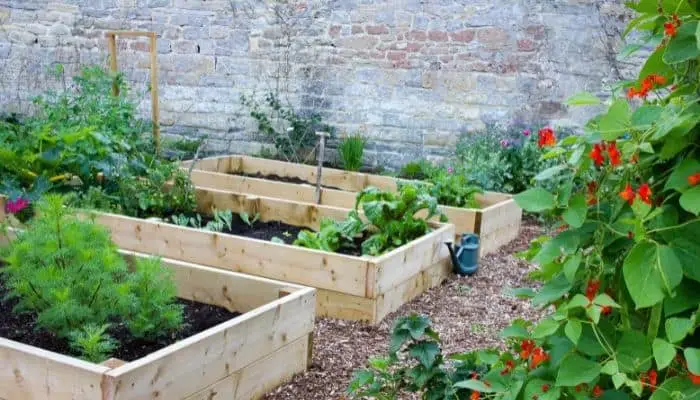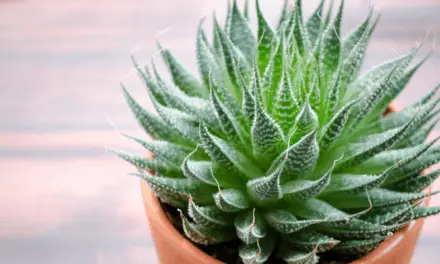If you have a slope in your garden, it might be tempting to stick in a few raised beds and not bother to level them.
But this can lead to your raised beds never being as productive as they could be.
Let’s look at why.
Table of Contents
Do Raised Beds Need To Be Level?

Yes, it is important to have your raised beds as close to level as possible. This allows the plants within your beds to receive an equal amount of water.
Building your raised beds on a slope will cause uneven water distribution among your plants.
Due to gravity, the roots of your plants at the high end of your raised garden bed will receive less water than the ones at the low end.
This can cause your plants to grow at different rates, it can put plants at the lower end of your raised bed at the risk of becoming waterlogged and it can put plants at the higher end at risk of becoming too dry.
But not to worry, if you are dealing with a slope in your yard, there are ways to level out a bed so that you won’t have those issues.
What Happens If A Raised Garden Bed Is Sloped?
Raised beds need to be level so that the soil within them will dry out evenly.
Plants have no difficulty growing on slopes but when you have a group of plants together in a sloped raised bed and you expect them to grow the same size or produce vegetables that are the same size, it usually doesn’t go to plan.
When you water plants on a slope, the highest part of the soil dries out first and there is an uneven distribution of moisture among your plants’ roots.
When plants within the same garden bed receive uneven amounts of water, they don’t grow evenly and if they are vegetable plants, often produce poor harvests.
If you want your garden to be as productive as possible, the raised bed needs to be as level as you can get it.
Related Article: Will Rabbits Jump Into Raised Beds? (And How To Keep Them Out)
It’s OK if the bed isn’t perfectly level, but you want it level enough so that water doesn’t want to travel downward.
There are other reasons why you want a raised bed to be level.
The main issue is watering but sloped soil may also lead to more movement and erosion.
From rain, wind, and animals, the soil can start to shift closer to the bottom of the bed, resulting in packing and an uneven distribution of the soil.
When soil packs together and becomes dense around plant roots, it can starve them of water and nutrients.
How To Level A Raised Garden Bed On A Slope
The best way to level a raised garden bed on a slope is to dig out the soil and set your garden box in the ground so that it sits level.
To do this you’ll need a spirit level, tape measure, a shovel, and a garden box.
You can nail planks together to make a rectangular box.
Do a quick YouTube search. There are loads of people putting garden boxes together really cheaply.
If you don’t have a spirit level, a level app on your smartphone will probably do the trick.
Step 1.
Place the garden box down flat on the slope, where you want it to go.
Step 2.
Place your level on top of one of the sides of the box and lift the lower end of the box until your spirit level reads level.
Step 3.
While holding the box level, use your tape measure to measure from the bottom of the box to the surface of the soil.
This measurement is the depth of soil you need to dig out from the higher end of the slope where your box is sitting.
Step 4.
Remove grass from the area where your garden bed is going to sit and dig down the required dept at the higher end of the slope.
This should leave your garden box sitting reasonably level but you may need to shuffle it around and prop it up at one end of another to get it all flush.
You can also fill the area with some gravel to help settle the box level.
Step 5.
Once your garden box is sturdy and sitting level you can fill it up with soil for planting.
Place Individual Containers Into Your Raised Beds
If the slope is not too severe and you don’t fancy all that digging in the soil, you could lay down your garden box so it is uneven and then fill it partway with gravel or sand.
You can then put smaller planting containers inside your garden box.
These smaller containers will be much easier to level by just placing them in the gravel and shifting them around until they are sitting flush.
Final Thoughts
Overall, you should try to avoid gardening in soil that is not level.
For the best results, try to make your garden bed as level as possible.
It doesn’t have to be exactly flush, but the closer, the better.
If you’re working on a slope, you’ll have to build a box for your raised bed that cancels out the angle.
Even though it is more hard work to create a level garden bed on a slope, your garden will look much better and your plants will thank you for it.
You won’t have to worry about uneven water, nutrient, and soil distribution, all of which being factors that lead to unhealthy plants.




